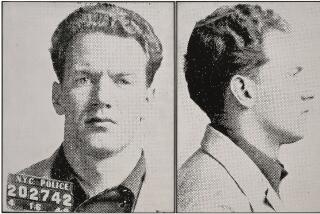Spiked!
HOW’S YOUR tummy? Feeling nauseated? Many newspaper editors worry sick about ruining your appetite, often refusing to run provocative editorial cartoons and illustrations that fail what’s known as the “breakfast test”: When you turn to the editorial pages in the morning, do your eggs over easy suddenly go down hard?
There are lots of reasons why editors decide political cartoons should not be published (like the ones on this page, all of which were rejected). At the Los Angeles Times, for instance, even revered former cartoonist Paul Conrad found that, over time, quite a few of his cartoons didn’t make it into print. Editors on the taste patrol spiked his portrait of Richard Nixon’s press-hating vice president, Spiro Agnew, urinating on newspapers, for example, as well as a caricature of Saddam Hussein exposing himself to the world to symbolize contempt for the international community.
For the record:
12:00 a.m. May 27, 2007 For The Record
Los Angeles Times Sunday May 27, 2007 Home Edition Opinion Part M Page 3 Editorial Pages Desk 1 inches; 36 words Type of Material: Correction
Cartoons: A caption accompanying a May 20 Opinion article about editorial cartoons that publications decided not to print said a drawing referred to “The Clinton-Lewinsky scandal, 1994.” It should have said “The Paula Jones scandal, 1994.”
The Times also declined to run a Conrad favorite -- a 1999 drawing of a wild-eyed elephant fornicating with a befuddled donkey above the caption “Congressional Bipartisanship.” (Given a second chance to run the cheeky but hardly obscene cartoon to accompany this article, The Times again primly said no.)
Another common reason cartoons get spiked (in addition to fears they might be too titillating or downright obscene) is the thou-must-not-offend attitude toward religion. In 2005, after Pope John Paul II died, for instance, the Hamilton Spectator in Canada killed an obituary cartoon that depicted the late pontiff cruising to heaven in a golden “popemobile.”
American editors showed their true colors -- various shades of yellow -- during the so-called intoonfadah. Hardly any major U.S. publication reprinted even one of the 12 Danish cartoons featuring Muhammad to illustrate the biggest story about cartooning since Thomas Nast took down Tammany Hall.
Hard-hitting cartoons drawn during wartime suffer as much scrutiny as religious-themed work. Clay Bennett, now at the Christian Science Monitor, bitterly recalls how the St. Petersburg Times silenced him during the Persian Gulf War: “I was allowed to rail ... until the bullets started flying, and then the boot heel of conventional thinking came down on me with a thud.” This time around, the boot landed on illustrator Peter Kuper. In 2004, he wired up the White House to the iconic image of a hooded and soon-to-be-shocked Abu Ghraib prisoner for the New York Times’ Op-Ed page. “The direct connection of the wire going to the White House didn’t fly,” Kuper said. “They want to be subtle enough so that they don’t get fingers pointed at [them] for, ‘Oh, you made that absolute statement,’ which is too bad because the Op-Ed page is made for just that type of thing.” The cartoon did not run.
And most cartoonists understand that there’s one subject that’s always off-limits: the newspapers they work for. “Anytime you are going after ownership or people above you, there is discomfort,” said Lee Judge, cartoonist at the Kansas City Star. “They think it’s funny, and they need three copies for their friends, but they don’t really want you to do it.”
Judge found that out when Disney briefly owned the Star. The premise of a Disney-owned newspaper sounded strange to Judge, as reflected in his mild-mannered cartoon that labeled the paper a “Mickey Mouse Operation.” The Star quietly shelved the cartoon -- the kind of self-protective and far too common decision that if, dear reader, you knew about, would truly make you queasy.
More to Read
Sign up for Essential California
The most important California stories and recommendations in your inbox every morning.
You may occasionally receive promotional content from the Los Angeles Times.










